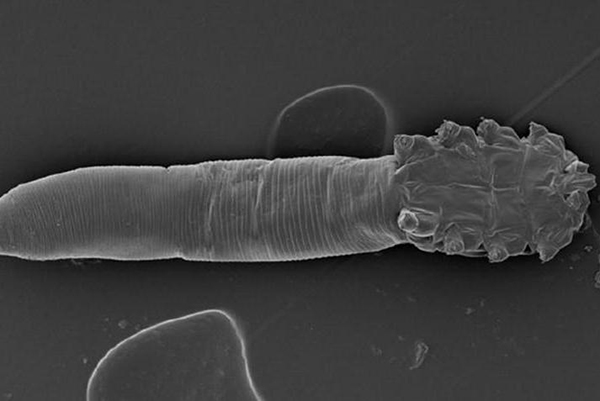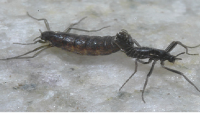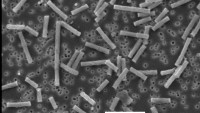Scientists Study Face Mites
| Emery Dennel | | Aug 29, 2014 08:25 AM EDT |
(Photo : USDA) Demodex folliculorum, shown magnified, is one of two types of face mite species living on humans.
In the latest edition of the journal PLOS One, researchers from N.C. State U, North Carolina Museum of Natural Sciences, and the California Academy of Sciences published a study about mites hosted in the human face.
Despite the fact that these microscopic face mites have been on the faces of human beings for a while now, not much is known about them.
Like Us on Facebook
But then again, maybe knowing of their existence and seeing them under a microscope might just be too much information already.
Megan Thoemmes, a graduate student at North Carolina State University and participant of the study, shared, "The first time I found one on my face I didn't sleep for four nights. But then Thoemmes backtracked, now apparently fascinated by the creatures of her face, actually, on everybody's faces. "They're actually pretty cute. With their eight little legs, they look like they're almost swimming through the oil," she explained.
Face mites, members of the arachnid class and, consequently relatives of ticks and spiders, exist on the faces of mammals, except for the platypus and its egg-laying mammalian relatives.
The study consisted of face scrapings of individuals of varying ages.
What the study found was that face mites are found on everybody's faces. Previously, skin samples only turned up mites around 20 percent of the time; however, most mites are elusive and, recent testing has proven that mite DNA residue is found on all human faces, even faces of cadavers.
The study also revealed that there are two species of face mites - the Demodex folliculorum and Demodex brevis. Although they only have one word different in their names, they are not genetically relatives.
Face mites also reproduce. It's not exactly a pretty picture, but mites mate on your facial skin, but don't release waste. Mites store all their waste in their body until they die and, eventually get absorbed by the oily layer in your epidermis.
Researchers also found out that microscopic creatures aren't in our skin when we are born and, through physical contact, we spread the mites around.
Tagsmites
©2015 Chinatopix All rights reserved. Do not reproduce without permission
EDITOR'S PICKS
-

Did the Trump administration just announce plans for a trade war with ‘hostile’ China and Russia?
-

US Senate passes Taiwan travel bill slammed by China
-

As Yan Sihong’s family grieves, here are other Chinese students who went missing abroad. Some have never been found
-

Beijing blasts Western critics who ‘smear China’ with the term sharp power
-

China Envoy Seeks to Defuse Tensions With U.S. as a Trade War Brews
-

Singapore's Deputy PM Provides Bitcoin Vote of Confidence Amid China's Blanket Bans
-

China warns investors over risks in overseas virtual currency trading
-

Chinese government most trustworthy: survey
-

Kashima Antlers On Course For Back-To-Back Titles
MOST POPULAR
LATEST NEWS
Zhou Yongkang: China's Former Security Chief Sentenced to Life in Prison

China's former Chief of the Ministry of Public Security, Zhou Yongkang, has been given a life sentence after he was found guilty of abusing his office, bribery and deliberately ... Full Article
TRENDING STORY

China Pork Prices Expected to Stabilize As The Supplies Recover

Elephone P9000 Smartphone is now on Sale on Amazon India

There's a Big Chance Cliffhangers Won't Still Be Resolved When Grey's Anatomy Season 13 Returns

Supreme Court Ruled on Samsung vs Apple Dispute for Patent Infringement

Microsoft Surface Pro 5 Rumors and Release Date: What is the Latest?












